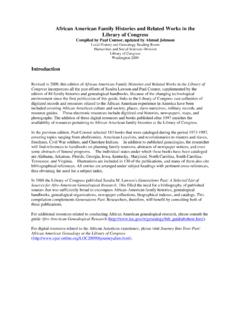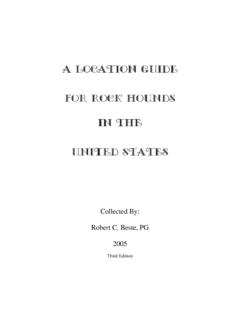Transcription of Growth and Production of Groundnut - …
1 SOILS, PLANT Growth AND CROP Production - Growth and Production of Groundnuts - Vara Prasad, Vijaya Gopal Kakani, Hari D. Upadhyaya Growth AND Production OF GROUNDNUTS. Vara Prasad Department of Agronomy, Kansas State University, Manhattan, KS 66506, USA. Vijaya Gopal Kakani Department of Plant and Soil Science, Oklahoma State University, Stillwater, OK. 74078, USA. Hari D. Upadhyaya International Crop Research Institute for the Semi Arid Tropics, Patancheru 502 324, Andhra Pradesh, India Keywords: Aflatoxin, drought, genetic resources, Growth and development, legume, S.
2 TE S. nitrogen fixation, oil seed, temperature stress. R. AP LS. Contents 1. Origin and Distribution C EO. 2. Taxonomy and Classification 3. Groundnut Production and Productivity Asia Africa E . North America H. South America PL O. Europe 4. Utilization M SC. 5. Growth and Development of Groundnut Growth Stages Seedling and Vegetative Growth Reproductive Growth and Maturity SA NE. 6. Nodule Formation and Nitrogen Fixation Root Colonization and Infection Nodule Development U. Nodule Function 7. Climatic Requirements 8. Soil Requirements 9.
3 Land Husbandry and Crop Management Cropping System Cultivar Selection Seedbed Preparation Planting Date Plant Population and Spacing Nutrition and Fertilizer Use Water Use and Irrigation Weed Management Harvesting, Drying and Storage 10. Abiotic Stresses Encyclopedia of Life Support Systems (EOLSS). SOILS, PLANT Growth AND CROP Production - Growth and Production of Groundnuts - Vara Prasad, Vijaya Gopal Kakani, Hari D. Upadhyaya High Temperature Stress Drought Stress Nutrient Stress 11. Biotic Stresses 12. Aflatoxins in Groundnut 13.
4 Genetic Resources 14. Conclusions Acknowledgements Glossary Bibliography Biographical Sketches Summary The Groundnut or peanut is one of the important legume crops of tropical and semiarid S. TE S. tropical countries, where it provides a major source of edible oil and vegetable protein. R. AP LS. Groundnut kernels contain 47-53% oil and 25-36% protein. The crop is cultivated between 40 N to 40 S of the equator. Groundnut is a self pollinated crop whereby flowers are produced above ground and, after fertilization, pegs move towards the soil, C EO.
5 And seed-containing pods are formed and developed underneath the soil. The productivity of groundnuts varies from 3500 kg/ha in the United States of America to 2500 kg/ha in South America, 1600 kg/ha in Asia, and less than 800 kg/ha in Africa. This is due mainly to various abiotic and biotic constraints. Abiotic stresses of prime E . importance include temperature extremes, drought stress, soil factors such as alkalinity, H. poor soil fertility and nutrient deficiencies. Groundnuts grow best in light textured PL O. sandy loam soils with neutral pH.
6 Optimum temperature for their Growth and development ranges from 28 to 30 C; the crop requires about 500-600 mm of well M SC. distributed rainfall. The main yield limiting factors in semiarid regions are drought and high temperature SA NE. stress. The stages of reproductive development prior to flowering, at flowering and at early pod development, are particularly sensitive to these constraints. Apart from N, P. and K, other nutrient deficiencies causing significant yield losses are Ca, Fe and B. U. Biotic stresses mainly include pests, diseases and weeds.
7 Among insects pests pod borers, aphids and mites are of importance. The most important diseases are leaf spots, rusts and the toxin-producing fungus Aspergillus. 1. Origin and Distribution The cultivated Groundnut or peanut (Arachis hypogaea L.) originated in South America. The term Arachis is derived from the Greek word "arachos", meaning a weed, and hypogaea, meaning underground chamber, in botanical terms, a weed with fruits produced below the soil surface. There are two most common names used for this crop Groundnut or peanut.
8 The term Groundnut is used in most countries of Asia, Africa, Europe and Australia, while in North and South America it is commonly referred to as peanut. The term Groundnut refers to the pods with seeds that mature underground; the connotation of peanut is because this crop belongs to the leguminous family which includes also other Encyclopedia of Life Support Systems (EOLSS). SOILS, PLANT Growth AND CROP Production - Growth and Production of Groundnuts - Vara Prasad, Vijaya Gopal Kakani, Hari D. Upadhyaya crops such as peas and beans.
9 It is a legume crop and not related to other nuts ( walnut, hazelnut or cashews). The terminology of nut is used due its unusual growing habit where flowers are formed above ground (soil) and after fertilization the gynoecium penetrates the soil and forms pods which contain seeds (kernels). In this manuscript the term Groundnut will be used due its wider acceptance. The earliest archaeological records of groundnuts in cultivation are from Peru, dated 3750- 3900 years before present (BP). Groundnuts were widely dispersed through South and Central America by the time Europeans reached the continent, probably by the Arawak Indians.
10 There is archaeological evidence of their existence from Mexico, dated 1300-2200. BP. After European contact, groundnuts were dispersed world-wide. The Peruvian runner type was taken to the Western Pacific, China, Southeast Asia and Madagascar. The Spanish probably introduced the Virginia type to Mexico, via The Philippines, in the sixteenth century. The Portuguese then took it to Africa, and later to India, via Brazil. Virginia types apparently reached the Southeast US with the slave trade. Gibbons et al. S. TE S. (1972) noted substantial secondary diversity in Africa and Asia.














